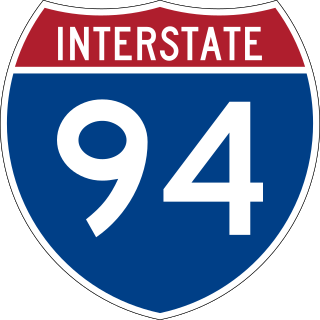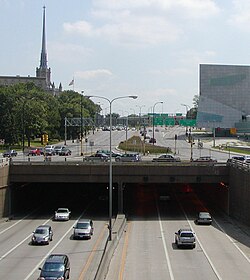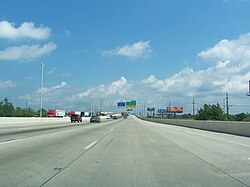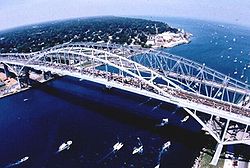Interstate 94
Interstate Highway across the upper Midwestern US From Wikipedia, the free encyclopedia
Interstate 94 (I-94) is an east–west Interstate Highway connecting the Great Lakes and northern Great Plains regions of the United States. Its western terminus is just east of Billings, Montana, at a junction with I-90; its eastern terminus is in Port Huron, Michigan, where it meets with I-69 and crosses the Blue Water Bridge into Sarnia, Ontario, Canada, where the route becomes Ontario Highway 402. It thus lies along the primary overland route from Seattle (via I-90) to Toronto (via Ontario Highway 401) and is the only east–west Interstate Highway to have a direct connection to Canada. It is the longest Interstate whose route number is not divisible by 5.
I-94 highlighted in red | |
| Route information | |
| Length | 1,555.43 mi[1] (2,503.22 km) |
| Existed | 1958–present |
| NHS | Entire route |
| Major junctions | |
| West end | I-90 / US 87 / US 212 in Lockwood, MT |
| |
| East end | Highway 402 at Canadian border on Blue Water Bridge in Port Huron, MI |
| Location | |
| Country | United States |
| States | Montana, North Dakota, Minnesota, Wisconsin, Illinois, Indiana, Michigan |
| Highway system | |
I-94 intersects with I-90 several times: at its western terminus; Tomah to Madison in Wisconsin; in Chicago, Illinois; and in Lake Station, Indiana. Major cities that I-94 connects to are Billings, Bismarck, Fargo, Minneapolis–Saint Paul, Madison, Milwaukee, Chicago, and Detroit.
Route description
Summarize
Perspective
Lowry Hill Tunnel in Minneapolis, Minnesota
I-894 west at the Zoo Interchange (I-94) in 2008
I-69/I-94's eastern terminus on the Blue Water Bridge at the Canadian border in Port Huron, Michigan, connecting it to Highway 402 in Point Edward, Ontario
Montana
I-94 begins at Billings and travels northeastward toward Glendive before exiting the state to the east. I-94 links seven counties, which are Yellowstone, Treasure, Rosebud, Custer, Prairie, Dawson, and Wibaux counties and passes near or through Miles City and Glendive while connecting with I-90 in Billings. The highway is notable for following the Yellowstone River from Billings through Glendive. Beyond the western terminus of I-94, I-90 connects westbound I-94 travelers to points west such as Butte; Missoula; Coeur d'Alene, Idaho; Spokane, Washington; and Seattle, Washington.
North Dakota
The route enters at Beach and passes through the Badlands near Medora (near the Theodore Roosevelt National Park South Unit). Further east, I-94 provides access to the North Unit of Theodore Roosevelt National Park, then passes through the cities of Dickinson, Mandan, Bismarck, Jamestown, and Valley City on the way to West Fargo and Fargo, where it leaves the state and crosses into Minnesota. Throughout the state, the route generally travels relatively straight east and west following both the railroad route and the former route of US Route 10 (US 10, called "The Old Red Trail") where its western terminus is at exit 343 in West Fargo.
The highway intersects with the Enchanted Highway 11 miles (18 km) east of Dickinson at exit 72. At New Salem, it passes Salem Sue, a 38-foot-high (12 m) sculpture of a Holstein cow and is clearly visible from I-94 on the south side of the road. A drive up the road to Sue will take visitors to a vantage point where they can see a panoramic landscape for many miles. Between Mandan and Bismarck, I-94 crosses the Missouri River with a view of the Northern Pacific/BNSF Railway Bridge on the south side of the road. At Steele, it passes the world's largest sculpture of a sandhill crane (named Sandy), which is 40 feet (12 m) tall and visible from I-94 on the south side of the road, just to the east of exit 200. At Jamestown, it passes the world's largest sculpture of the buffalo (actually bison) named "Dakota Thunder", which is 28 feet (8.5 m) tall and is visible from I-94 on the north side of the road. US 52 is concurrent with I-94 from Jamestown to the Minnesota state line. approximately milemarker 275 on the westbound lanes between Jamestown and Valley City, there is a small green sign marking the Laurentian Divide, which marks a continental divide where rivers south of the divide drain into the Gulf of Mexico, while the rivers north flow into the Arctic Ocean. The highway reaches Fargo, before the Red River.
Minnesota
Leaving Fargo and entering Moorhead, Minnesota, I-94/US 52 crosses the Red River. East of Moorhead Municipal Airport, the Interstate travels in a northwest–southeast trajectory past Fergus Falls, Alexandria, and St. Cloud on the way to the Twin Cities and eastward out of the state.
The road crosses the Mississippi River in Minneapolis between the Prospect Park and Seward neighborhoods. As it crosses over the only true gorge along the Mississippi's entire 2,350-mile (3,780 km) length, where steep bluffs extend to the waterline.[2] The highway joins Minneapolis and Saint Paul together where it meets Minnesota State Highway 280 (MN 280). US 52 leaves I-94 after running concurrently with I-94 from the North Dakota state line and heads southbound toward Rochester. In the Twin Cities, the routing of the highway is politically charged, primarily through many historic working-class and Black neighborhoods.[3][4] In Saint Paul, the routing of I-94 is set through and displaces the historic Rondo neighborhood, which prior to the highway construction was the largest Black community in Saint Paul.[5][6][4]
East of Saint Paul, I-94 leaves Minnesota between Lakeland, Minnesota, and Hudson, Wisconsin, while crossing the St. Croix River.
Wisconsin
I-94 enters Wisconsin east of the Twin Cities at Hudson. It traverses the hilly terrain of northwest Wisconsin, crossing the Red Cedar River near Menomonie. East of Menomonie, I-94 junctions with WIS 29, a major East–West expressway connecting I-94 with Wausau, and Green Bay. It then passes Eau Claire before turning southeastward and joining with I-90 in Tomah. Southeast of Tomah, the highway passes the major tourist area of Wisconsin Dells. Here, vacationers can find a multitude of water parks, camping, amusement parks, zoos, river excursions, as well as lodging and shopping. Further southeast, I-94 joins up with I-39 in Portage at the base of Cascade Mountain, a popular ski area. Just south of Cascade Mountain, I-94 crosses over the Wisconsin River. I-94 leaves I-90 and I-39 east of the state capitol of Madison and resumes its easterly path toward Milwaukee. I-94 weaves its way into Downtown Milwaukee before turning south and heading to Chicago, entering Illinois at Pleasant Prairie.
Illinois
In the state of Illinois, I-94 runs south from Wisconsin to Indiana via downtown Chicago. It is tolled on the Tri-State Tollway to the I-94/I-294 split; it then runs east to the Edens Expressway, where it soon joins again with I-90 on the Kennedy Expressway and turns south through the city of Chicago. I-90 leaves south of downtown Chicago to the Chicago Skyway. At I-80, I-94 runs east to Indiana on the Kingery Expressway.
Indiana
In the state of Indiana, I-94 runs east from Illinois concurrently with I-80. It crosses I-90 (Indiana Toll Road), where I-80 joins I-90 east toward Ohio. I-94 continues northeasterly, paralleling the Lake Michigan shoreline into Michigan. The 55-mile-per-hour (89 km/h) speed limit used to continue east of exit 26; now it ends a mile (1.6 km) east of I-80/I-90, where the speed limit goes up to 70 mph (110 km/h) on eastbound I-94.[7] Between milemarkers 0.0 and 15.5, the highway is also posted along with I-80. Between milemarkers 15.6 and 19.0, I-94 is posted alone.
Michigan
I-94 runs north along Lake Michigan to St. Joseph and Benton Harbor where it meets US 31 and I-196 before heading east toward Detroit. It turns northeast to Port Huron where it meets I-69 and ends at the Blue Water Bridge, where it becomes Ontario Highway 402 in Point Edward, Ontario.
History
Summarize
Perspective
The first section of I-94 completed with Interstate funds (under the Federal-Aid Highway Act of 1956) was a 12-mile (19 km) section between Jamestown and Valley City, North Dakota, in 1958.
North of Chicago, I-94 has been widened from six to eight lanes from Illinois Route 22 (IL 22, Half Day Road) to just south of the Wisconsin state line at IL 173 and 95th Street to 159th Street. Construction began in 2009 to completely rebuild I-94, including expansion to eight lanes, from the Wisconsin–Illinois border through the Mitchell Interchange in Milwaukee. This construction is expected to be completed in 2021.[8][needs update]
In 2005, the I-94 bridge over the Crow River near St. Michael, Minnesota, about 35 miles (56 km) northwest of Minneapolis, was rebuilt. In 2006, a project to widen I-94 east of Downtown Saint Paul between MN 120 and McKnight Road from four to six lanes was completed. The interchange at 95th Avenue North in Maple Grove, Minnesota, was rebuilt with a new, wider bridge that replaced the two-lane bridge there, which was demolished in July 2006.
The expanded Marquette Interchange in Downtown Milwaukee was completed in August 2008 at a cost of $810 million (equivalent to $1.13 billion in 2023[9]).
In Detroit, I-94 was routed over the existing Edsel Ford Freeway and remained signed as such until the late 1980s when Michigan deemphasized proper names on Interstate guide signs. Its interchange with the Lodge Freeway, built in 1953, is significant as the first full-speed freeway-to-freeway interchange built in the US.[10]
From September 2007 to October 2008, the Minnesota Department of Transportation (MnDOT) added a temporary extra lane to I-94 between northbound I-35W and Minnesota State Highway 280 in the Twin Cities to help relieve traffic congestion caused by the collapse of the I-35W Mississippi River bridge. As a result, this portion of I-94 was not up to Interstate Highway standards during this time period.
Major intersections
Summarize
Perspective
- Montana


 I-90 / US 87 / US 212 in Billings
I-90 / US 87 / US 212 in Billings US 12 near Miles City
US 12 near Miles City- North Dakota
 US 85 in Belfield
US 85 in Belfield I-194 in Bismarck (unsigned, carried by the Bismarck Expressway)
I-194 in Bismarck (unsigned, carried by the Bismarck Expressway) US 83 in Bismarck
US 83 in Bismarck
 US 52 / US 281 in Jamestown
US 52 / US 281 in Jamestown US 10 in West Fargo
US 10 in West Fargo
 I-29 / US 81 in Fargo
I-29 / US 81 in Fargo- Minnesota

 I-494 / I-694 in Maple Grove; access to the west end of the Twin Cities beltway
I-494 / I-694 in Maple Grove; access to the west end of the Twin Cities beltway I-394 in Minneapolis; the spur route from Minneapolis to Minnetonka
I-394 in Minneapolis; the spur route from Minneapolis to Minnetonka I-35W in Minneapolis; concurrent for less than one mile (1.6 km)
I-35W in Minneapolis; concurrent for less than one mile (1.6 km) I-35E in St. Paul; concurrent for less than one-half mile (0.80 km)
I-35E in St. Paul; concurrent for less than one-half mile (0.80 km)
 I-494 / I-694 in Oakdale-Woodbury; the east end of the Twin Cities beltway
I-494 / I-694 in Oakdale-Woodbury; the east end of the Twin Cities beltway- Wisconsin
 US 53 in Eau Claire
US 53 in Eau Claire I-90 in Tomah; concurrent until Madison
I-90 in Tomah; concurrent until Madison I-39 at Portage; concurrent until Madison
I-39 at Portage; concurrent until Madison
 I-41 / I-894 in West Allis
I-41 / I-894 in West Allis
 I-43 / I-794 in Milwaukee
I-43 / I-794 in Milwaukee

 I-41 / I-43 / I-894 in Milwaukee
I-41 / I-43 / I-894 in Milwaukee- Illinois
 I-41 in Zion
I-41 in Zion I-294 in Deerfield
I-294 in Deerfield I-90 in Chicago; concurrent through to the junction with the Chicago Skyway
I-90 in Chicago; concurrent through to the junction with the Chicago Skyway I-55 in Chicago
I-55 in Chicago I-90 in Chicago
I-90 in Chicago I-57 in Chicago
I-57 in Chicago
 I-80 / I-294 in South Holland; concurrent until Lake Station, Indiana
I-80 / I-294 in South Holland; concurrent until Lake Station, Indiana- Indiana
 I-65 in Gary
I-65 in Gary US 41 in Hammond
US 41 in Hammond US 6 in Lake Station
US 6 in Lake Station
 I-80 / I-90 in Lake Station
I-80 / I-90 in Lake Station US 421 near Michigan City
US 421 near Michigan City
 US 20 / US 35 near Michigan City
US 20 / US 35 near Michigan City- Michigan

 I-196 / US 31 near Benton Harbor
I-196 / US 31 near Benton Harbor US 131 in Kalamazoo
US 131 in Kalamazoo I-194 in Battle Creek
I-194 in Battle Creek I-69 in Marshall
I-69 in Marshall US 127 in Jackson
US 127 in Jackson US 23 near Ann Arbor
US 23 near Ann Arbor I-275 in Romulus
I-275 in Romulus US 24 in Taylor
US 24 in Taylor I-96 in Detroit
I-96 in Detroit I-75 in Detroit
I-75 in Detroit I-696 in Roseville
I-696 in Roseville I-69 in Port Huron; concurrent to the border
I-69 in Port Huron; concurrent to the border Highway 402 at Canadian border
Highway 402 at Canadian border
Auxiliary routes
- Source: FHWA[12]
References
External links
Wikiwand - on
Seamless Wikipedia browsing. On steroids.









